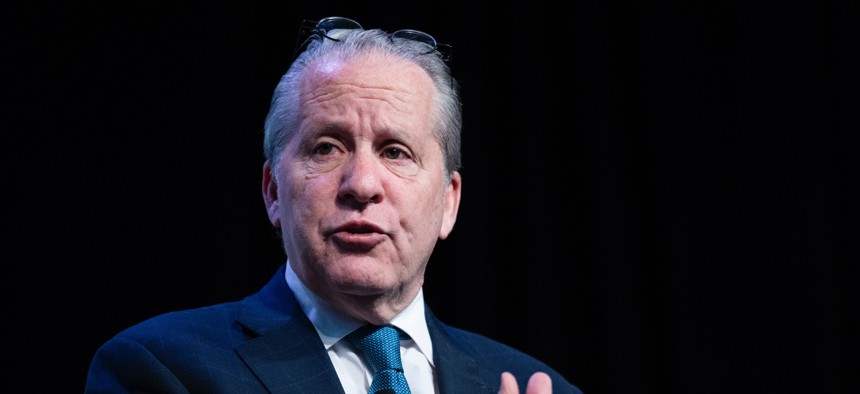White House sends anti-fraud wishlist to Congress as stakeholders await identity executive order

Gene Sperling, White House American Rescue Plan Coordinator, told reporters Wednesday that the anticipated identity theft executive order is being vetted by multiple agencies' counsel’s offices ahead of a pending release. Tom Williams / Getty Images
Asked when the long-anticipated executive order would be coming out, senior advisor to the President Gene Sperling told reporters to “stay tuned” as the measure winds through legal approvals.
The White House announced a $1.6 billion proposal in fraud and oversight investments on Thursday. It asks for $600 million in identity theft and fraud prevention funding, but stakeholders are still waiting for a long-awaited executive order to address identity theft in public benefits first promised in President Biden’s 2022 State of the Union address.
The funding wishlist is a “separate, mandatory proposal” from the usual appropriations cycle, White House senior advisor Gene Sperling told reporters on Wednesday, noting that the hope is that it could garner bipartisan support.
In addition to the fraud prevention asks, the White House is also calling for $600 million for investigations and prosecutions of fraud perpetrators and $400 million for victims of identity theft.
The proposal comes as stakeholders continue to wait for a long-anticipated executive order on identity theft in public benefit programs.
The White House fact sheet on the new proposal states that “through an upcoming executive order, the President will direct actions designed to provide guidance to federal agencies on the best ways to prevent identity theft in public benefits.” Under consideration is a push for agencies to use the government’s Login.gov identity solution, according to a draft obtained by FCW.
Asked in a Wednesday press call with reporters when people can expect to see the executive order, Sperling told them to “stay tuned,” noting that “when you have this many departments and you actually have an executive order that is requiring an actual change of behavior, it requires a level of vetting from Justice Department, the [Office of Legal Counsel] and each counsel’s office that is a bit more from other executive orders.
“It should be out soon, but I don’t want to predict what I can’t control, which is the time it takes to get everybody to completely – every counsel’s office to completely sign off,” said Sperling.
The White House wants half of that $600 million to go to fraud prevention in public benefit programs via modernization of agency identity systems and “enhancements to lessen the impact on victims of identity theft.” Sperling said this funding “is certainly to help with the resources that will be needed for the identity theft executive order.”
The funding would also “facilitate improved data sharing and enhancement of ‘yes’ / ‘no’ attribute validation services” – where agencies verify data submitted to them like name or birthday to what the government has on file – the White House fact sheet states.
Another $150 million chunk “would ensure that effective oversight and the best practices and lessons learned from the pandemic are institutionalized,” the fact sheet states. “This would include funding for under-resourced [inspectors general], such as the Department of Energy, Department of Agriculture and the Environmental Protection Agency.”
The other $150 million would be split between making a permanent anti-fraud data and analytics capability analogous to the Pandemic Analytics Center of Excellence set up for watchdogs during the pandemic and expanding the Treasury Department’s Do Not Pay service. The White House also calls on Congress to put requirements into law that agencies can’t skip payment integrity verification steps for loans and grants over $25,000.
The White House also says that it plans to propose legislation in its forthcoming budget request around preventing and recovering improper payments in the unemployment system in particular, and the proposal points to existing jobless aid funding from the American Rescue Plan Act already used for anti-fraud and modernization efforts in the unemployment system.
The proposal “gives you a very strong sense of the significant action that's being taken,” said Sperling. Speaking of the development of the executive order and the timeline, he said that “it’s not preventing us from moving forward on several of the components that would be encouraged.”
The announcement of the proposal falls on the same day as the national cybersecurity strategy, which also included a section on digital identity and the importance of secure identity solutions in the cybersecurity beyond the more limited focus of public benefit programs alone that the White House says the executive order will focus on.
“Cybersecurity has long been an afterthought across many sectors, only considered when something has gone wrong,” said Jordan Burris, former chief of staff in the Office of the Federal CIO and current vice president head of public sector strategy at Socure in a statement. “I’m encouraged to see the U.S. lean into developing a stronger digital identity ecosystem and infrastructure.”
Another longtime identity stakeholder, former senior executive at the National Institute of Standards and Technology and current head of the Better Identity Coalition Jeremy Grant, told FCW in a statement that, “We are thrilled to see the Biden-Harris administration call out digital identity as a critical national cybersecurity priority… It’s time to focus on prioritizing more robust digital identity solutions that can improve security and privacy for all Americans.”






